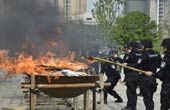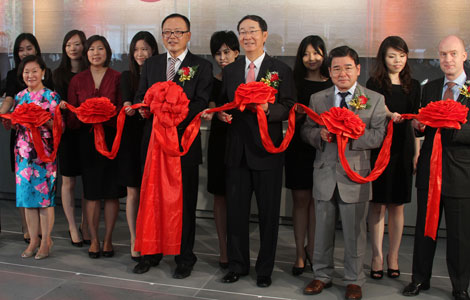Experts urge China to detail port emissions
Updated: 2014-07-04 08:38
By Wu Wencong (China Daily)
|
||||||||
China should establish emissions inventories for all major port cities as soon as possible to detail pollutants from ships and ports, experts have suggested.
They say these pollutants may account for as much as 20 percent of the cities' airborne pollutants and have also called for the diesel fuel standard for ships to be strengthened to reduce pollution.
Ding Yan, deputy head of the Environmental Protection Ministry's vehicle emissions control center, said pollutants generated by ships and the port in Hong Kong contributed to more than 50 percent of the region's airborne pollution.
"The proportion for some major port cities on the mainland, as some research has shown, can reach as high as 20 to 30 percent," Ding said.
He was speaking at a seminar on Thursday held by the Natural Resources Defense Council, an international nonprofit environmental organization.
A white paper from the organization on the prevention and control of shipping and port air emissions said pollutants generated by ships and ports include PM2.5 - particles smaller than 2.5 microns in diameter that can enter the lungs - PM10, nitrogen oxide and volatile organic compounds.
The white paper said the amount of PM2.5 emitted by a medium-sized container ship in one day is equivalent to that emitted by 500,000 cars running on diesel.
It said 70 percent of the pollutants are discharged within 400 km of coastlines and can reach up to 2,500 km inland.
David Pettit, a senior attorney at the council, said: "China is home to seven of the 10 busiest container ports in the world. The country's major port cities are also some of the most densely populated cities in the world, posing an even higher risk to public health."
He recommended that the central government set up a detailed emissions inventory for each major port city, as the United States government has.
Ding, from the Environmental Protection Ministry, agreed, saying that funding and technology are needed to fulfill it.
Pettit said the US has also established an emissions control area under the International Maritime Organization. All international oceangoing vessels have to switch to low-sulfur fuel when berthing.
Ding said most of the vessels berthing at Los Angeles are from China. To meet the strict local standard, many owners have converted their ships to ensure compliance.
"But they have to refuel in Singapore or Japan during the voyage because they can't find the low-sulfur diesel in China," he said.
Ding added that major fuel producers in China already have the technology, but don't have the incentive to produce the fuel because they set the standard themselves.
However, Ding's view was rejected by a staff member at Sinopec Group, one of the three largest oil producers in China.
The employee, who asked not to be named, said the fuel standards, regardless of whether they are for vehicles or ships, are set after negotiations with vehicle users and producers, rather than being decided by fuel producers.
Du Juan contributed to this story.
wuwencong@chinadaily.com.cn

 Macy's 'Fourth' show will include made-in-China fireworks
Macy's 'Fourth' show will include made-in-China fireworks
 Smithsonian Folklife Festival 2014 features China and Kenya
Smithsonian Folklife Festival 2014 features China and Kenya
 Xi urges US to view China 'objectively'
Xi urges US to view China 'objectively'
 Xbox One readies for national debut
Xbox One readies for national debut
 Political plan
Political plan
 Naturalization ceremony at New York Public Library
Naturalization ceremony at New York Public Library
 Bridging the culture gap
Bridging the culture gap
 Consumers from China prefer niche luxury items
Consumers from China prefer niche luxury items
Most Viewed
Editor's Picks

|

|

|

|

|

|
Today's Top News
Private, foreign investment to aid tourism industry
Culture the best basis for ties
Chinese turns to US for milk products
Giving voice to voiceless people
China's presence in RIMPAC 'significant'
US hopes high for S&ED
Restrictions loosened in Shanghai trade zone
Top-level general expelled for graft
US Weekly

|

|








